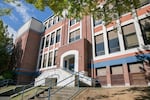At a recent Portland Public Schools board meeting, board member Michelle DePass envisioned a new Jefferson High School campus in the years to come. It would be full of students, offering strong academics with the main school building less removed from the nearby commercial corridor of North Killingsworth, rather than a football field away as it stands now. She referred to it as a “porch” and an “entryway” linking the school and a historically Black neighborhood in Portland.
“It really is inviting the community in, shows the students that we care about them,” DePass said.
But getting to that future Jefferson will now take more money and patience than initially planned.

The outside of Jefferson High School in Portland on September 6, 2023. The latest plans for Jefferson reflect an increase of $120 million from earlier estimates.
Caden Perry / OPB
Jefferson comes near the end of a long line of high schools that PPS has rebuilt as part of a multi-billion-dollar effort to modernize, upgrade and improve the safety of the district’s aging buildings backed with money from voter-approved bond measures.
Last fall, district officials heard repeatedly from parents and other members of the Jefferson High community that they disagreed with district plans to move students from the North Portland high school to the Marshall campus — a construction “swing” site in Southeast Portland used during several other school projects. In November, PPS officials signaled a willingness to keep students on-site through construction, as occurred for Lincoln and Roosevelt high school rebuilds, but they warned that doing so could drive up costs.
Now, we know how much more it’s likely to cost.
Rebuilding Jefferson High School through the earlier approach, with students moved to Marshall, was slated to cost $287 million. In addition to having students out of the way, project designers planned to maintain a central part of the Jefferson building, which was built in 1909 and is considered a contributing historic resource.
The new plan, based on keeping students at Jefferson during construction, removing the historic designation, demolishing the entire school building and building an entirely new school is $407 million.
The increase of $120 million is partly because costs will go up as construction is delayed, but is also due to the new design having more expensive structures (increase of $16 million), interiors ($17.7 million increase), and electrical systems ($25 million more), among other changes.
Construction will also begin a year later, as design and land-use reviews and permitting are expected to take much of the next two years. Construction is projected to start in late 2025, but students won’t be fully out of school-in-a-construction-zone until mid-2029, when the athletic fields are set to be reopened.
The new Jefferson will also be 20,000 square feet smaller, with the main building shifting northward toward the Portland Community College Cascade campus on Killingsworth. Athletic fields are slated to occupy the southern two-thirds of the site.
The Jefferson modernization presents some political challenges. For one, there are not sufficient bond funds from the measure voters approved in 2020 to cover the costlier rebuild. That means part of the cost will have to be included in a future bond measure, which will need the approval of Portland voters. The school district has been in that situation before, when the 2017 bond didn’t provide enough money to fully rebuild Benson Polytechnic High School, and that project had to also rely on money from the 2020 bond.
In addition, the planned 1,700-student school would need enrollment boundary changes for Jefferson to actually fill with students. Jefferson’s current enrollment is below 600.
A big reason for Jefferson’s relatively small student body is the school’s unique enrollment rules. Families who live in the vicinity of Jefferson High School can choose to attend Jefferson, or one of three other high schools (Grant, McDaniel or Roosevelt), depending on their location. Those other three high schools have all completed major renovation projects already.
School board member Andrew Scott flagged for fellow board members that involving affected communities in a discussion of district boundaries is inevitable and will not be easy.
“What we haven’t really done is talk about what that’s going to mean. I don’t think the community has internalized what that means,” Scott said, noting that boundary changes could affect hundreds of households.
“It means redrawing high school district boundaries, and doing so relatively quickly. We know that will be a highly political, contentious process.”
DePass, who lives within the Jefferson boundary area, agreed it would be a difficult process, but would be worth it, in the long run.
“The school should be as great as any other school, to draw the students in,” DePass said, noting that the ultimate goal is a Jefferson High School that families want to send their children to. “I’m looking down twenty years when we have a fully enrolled high school, with people thriving — but you’re right, that’s going to be a hard conversation.”
